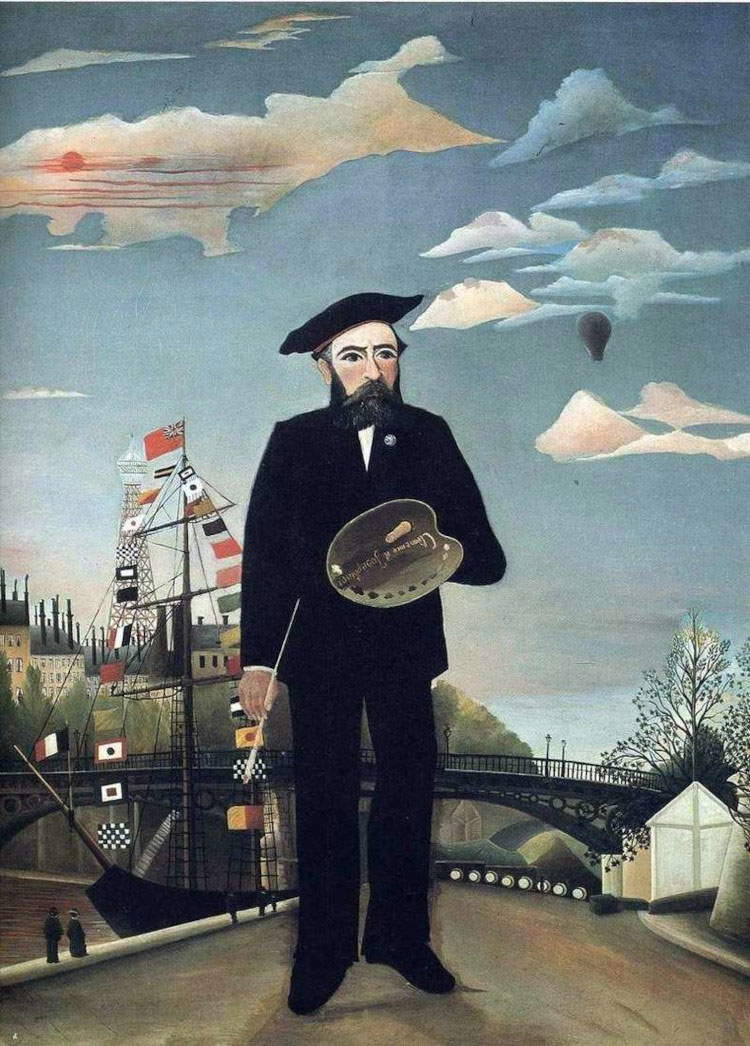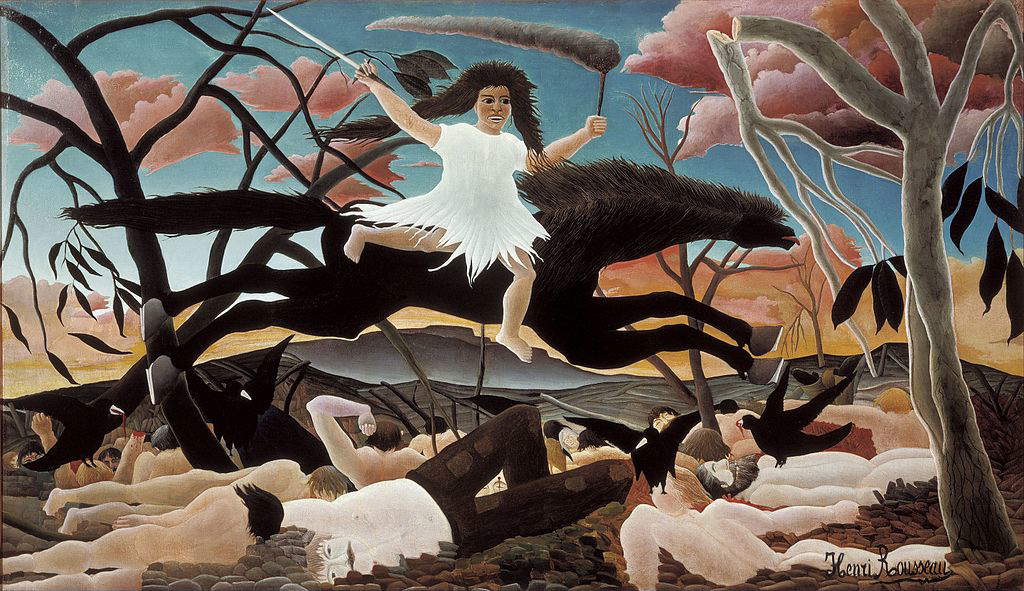Henri Rousseau (Laval, 1844-Paris, 1910), known as the Customsman because that was his job (he worked in fact at the Paris customs house and was in fact an artist for pleasure), occupies an important place in art history. Devoid of any training, Rousseau knew that his vocation was art, so when at the age of forty-one he resigned from his position as a clerk at the Paris customs house, he was able to devote all his time to painting. His artistic inspirations came from the Paris Zoo and botanical gardens: here he meticulously copied exotic plants and birds, which he then depicted in his canvases, giving the impression that he had really been to these paradisiacal places.
Due to his way of conceiving art and his elementary and simple style he was considered the leader of primitive painting and naïve art (which literally means “naïve”). If his work stands on the fringes of every artistic trend of the time this does not mean that Rousseau lived in an isolated world. He participated, at the invitation of Paul Signac, in the Salon des Indépendants and the Salon d’Automne, got to know many artists such as Robert Delaunay, Pablo Picasso, and intellectuals such as the famous poet Guillaume Apollinaire. Avant-garde artists recognized in his art the possibility of escaping modernity. The Customsman Rousseau made important contributions to Surrealism and Magic Realism, which in fact found the roots of their art in the French painter.
 |
| Portrait of Henri Rousseau |
Henri Rousseau was born in Laval on May 21, 1844. Little Henri attended elementary school at the Laval Institute, at that time still directed by its founder, Abbot Jules Dours. Henri did not show a particular passion for studies, so at the age of sixteen he dropped out of high school. In 1863 he was hired as a secretary by a lawyer in Angers from whom he stole ten francs and some stamps. Following this event his parents, outraged and humiliated by their son, forced him to enlist as a volunteer in the army. In 1868 his father died, so Henri left the army and moved to Paris where he worked for a time as a secretary for a bailiff. In the capital he got to know 18-year-old Clémence Boitard, his future wife and muse. The couple had a son, Henri-Antatole-Clément, who died prematurely at not even a year old. Henri, distraught over the loss of his son and tired of assisting his bailiff in foreclosing on poor people’s houses, had a relative recommend him for a job at the Paris Dole. In December 1871 he was hired and remained there until 1893. The latter employment allowed him to devote much of his time to painting. Moreover, the work characterized his identity in artistic circles, which in fact nicknamed him Rousseau the Customsman.
At the age of almost forty, Henri learned to paint as a self-taught artist, although he followed the advice of the two academic painters Felix Auguste Clément and Jean-Léon Gérome. It was through the recommendation of the painter Felix Clément that Rousseau obtained permission to work at the Louvre Museum practicing copies of masterpieces by the Old Masters. In 1884 he was rejected by the Salon Officiel but was expressly invited by the artist Paul Signac to the Salon des Indépendants, in which he also regularly participated in the following years. Camille Pissarro was greatly fascinated by Rousseau’s painting, whose rich colors and balanced values he extolled. In May 1887 Clémence, the painter’s wife, died of consumption. Rousseau said it was his wife who “held his hand to guide him in painting,” and her unexpected passing caused him immense grief. The painter wrote a literary work, A Visit to the Exposition of 1889. The work, written in 1889 in a very elementary style, recounts a visit to the Universal Exposition in Paris by a Breton family that is amazed by African culture and the immense Eiffel Tower. The play was not published until 1947 by Tristan Tzara, the father of Dadaism, and was first performed in 1968 at the Festival du Théàtre in Nancy. During the 1890s the painter devoted himself assiduously to painting, and it was during this period that the first canvases with an exotic character appeared. The critics of the time were very harsh on the Doganer: there was no shortage of negative criticism in the magazines, and his works triggered strong hilarity among the viewing public.
In December 1893 the painter finally left his employment at the Paris customs house to devote himself entirely to painting. The duty’s pension was not large enough so the artist began giving lessons in solfege and violin, passions he cultivated as a child. Rousseau, aspiring to be a complete artist, wrote a melodrama in 1899 entitled The Revenge of a Russian Orphan. This work, like its predecessor, was also published in 1947 by Tristan Tzara. In 1899 he married the widow Joséphine Nourry and in the same year produced an allegory of his two marriages, which he entitled The Present and the Past. In 1905 he exhibited for the first time at the Salon d’Automne, and in the catalog his name appeared alongside those of Henri Matisse and Paul Cézanne, making the Doganiere very proud. At the twenty-sixth Salon des Indépendants in 1907, the Customs Officer Rousseau hoped to sell the painting entitled Representatives of Foreign Powers Come to Greet the Republic in Peace to the State. This did not happen and eventually the work was sold to merchant and collector Ambroise Vollard. During the 1907 exhibition he also had the opportunity to meet the German critic Wilhelm Uhde, who greatly appreciated his art and later not only wrote the first monograph on the painter but also became his close friend. Things began to improve for the painter, who in fact, began to be held in high esteem by younger artists: Pablo Picasso was greatly fascinated by the Doganiere, and the Italian artist Ardengo Soffici greatly admired his works, comparing them in some respects to those of the ancient master of the fifteenth century, Paolo Uccello. Although commercial success was rather meager, Rousseau continued to paint until his death, which occurred on September 2, 1910, following an illness.
 |
| Henri Rousseau, Carnival Evening (1886; oil on canvas, 117.4 x 89.61 cm; Philadelphia, Philadelphia Museum of Art) |
 |
| Henri Rousseau, Me, portrait-landscape (1890; oil on canvas, 143 x 110 cm; Prague, Národní Galerie) |
 |
| Henri Rousseau, Surprise (1891; oil on canvas, 128.9 x 161.9 cm; London, National Gallery) |
 |
| Henri Rousseau, War (1894; oil on canvas, 114 x 195 cm; Paris, Musée d’Orsay) |
Rousseau’s works were born at the turn of the 19th and 20th centuries, an extremely fertile period for the avant-garde art that was developing in Paris. The Doganer’s paintings were highly original from the start, and such stylistic independence does not allow the artist to be placed in any avant-garde trend or movement of the period. Henri Rousseau depicted mainly tropical forests, rich jungles, and exotic animals. The artist never had a chance to actually see all these places: nevertheless, he employed all his imagination and fantasy, resulting in original works that lie somewhere between reality and dream. The primitive and elementary style of his canvases greatly fascinated critics and young artists who found the sense of mystery, enchantment, and dream that shone through his canvases interesting. Rousseau was called a naïve artist, meaning by this term spontaneity, estrangement from the cultural debates of the time, independence from specific currents and trends, and above all a naïve but genuine attitude toward the surrounding reality.
The painter’s fairy-tale and unreal poetics were perceptible from his earliest works, as in Una sera di carnevale (1886). In the center are two figures, a man and a woman, wearing light-colored clothes and surrounded by a forest. The title should evoke a moment of joy and happiness, however, silence, loneliness and a certain melancholy note characterize the painting. The two figures are reminiscent of a couple in love, evoking a sense of serenity. Such tranquility is, however, illusory as the slender trees rising toward the sky suggest a feeling of loneliness, also emphasized by the wide space and dark colors in which the two figures are placed.
One of the Doganiere’s masterpieces is I, portrait-painting (1889, first exhibited at the Salon des Indépendants in 1890. The work did not go unnoticed, in fact it provoked much comment and laughter among the public who did not appreciate the style of the painting judged primitive and elementary. In the foreground Henri holds a palette and brush, symbols of his art, while in the background Parisian buildings introduce the Eiffel Tower, built for the 1889 World’s Fair. Engraved on the palette are the names of his two wives and muses: Clémence, his first wife, and Josephine, his second. In this canvas it was immediately possible to notice some of the painter’s characteristic traits: flat color drafting, lack of geometric perspective, and finally the solid, simplified structures.
Surprise! (1891) was the first canvas of an exotic character, the first of a long series that characterized his art from the beginning. The work, unlike his later ones, is distinguished by the eventful character it gives off: the lightning in the background, the twisting of leaves and branches, the course of the grass, and the flight of the tiger in the center of the work. There are also other elements in this canvas that are not found in later works of this genre, such as the impression of inlay that emanates from the canvas, but also the very careful cutting of the outlines, and the leaves that are exaggeratedly large.
Rousseau wished to create a painting with large dimensions, and this led him to create the work The War (1894), which is followed by the subtitle: it passes terrifyingly, leaving despair, tears, and destruction everywhere. The subject of the work is an apocalyptic image that Rousseau drew on from a caricature of the time. In the center of the work Discord, an armed woman, leaps with her wild black horse over a field full of corpses. In the lower part of the canvas Rosseau depicted the effects of war, here expressed by crows feeding on human corpses. The entire surrounding landscape alludes to the consequences of war, except for the pink clouds in the background.
One of the most famous works that best represents Rousseau artistically is the Sleeping Gypsy, (1897). The center of the work depicts a sleeping woman under the moonlight, flanked by a mandolin and a water bottle. Near the woman an intrigued lion approaches her without attacking her. In the background a blue sky overlooks a beautiful hilly landscape. In this painting the arista played with light effects, color modulation and chiaroscuro transitions as can be seen in the animal’s mane, mandolin and the right shoulder of the female figure. What is interesting about this painting is the relationship the artist wanted to establish between the two subjects: the woman is depicted sleeping and therefore vulnerable, while the lion, recognizing the woman’s difference from his own, appears fascinated and intrigued. Stylistically, the landscape and figures are clean, the brushstrokes soft, almost in the manner of academic painters.
At the Salon D’Automne of 1905 the work Antelope Assaulted by a Lion (1905) was exhibited for the first time. The peculiarity of this painting, compared to previous ones, is to be found in the figure of the lion: the feline, in fact, was always depicted as a calm and serene animal; instead, here Rousseau gave the animal a cruel and savage role.
The work The Snake Charmer (1907), was commissioned by the mother of French painter Robert Delaunay. In the center of the work a long-haired woman charms snakes with a flute. In addition to the snakes, there are other animals in the canvas: at the top to and right among the leaves of the trees, a bird can be glimpsed, and at the bottom left, next to the figure of the woman, a flamingo. In the background a wide river is bordered by the thick vegetation while above the moon reflects its light on the river. The fantastic and surreal universe that the Doganer was able to express in his art allowed him to be greatly admired by Surrealist painters, particularly Salvator Dalí to René Magritte.
The Football Players (1908) is unique, compared to earlier works depicting jungles and exotic worlds. The painting testifies to how at the end of his artistic career, the Doganiere had great freedom in the choice of his subjects and the way they were treated. Rugby began at the time to be a popular sport in France. In 1908 the first match was held in Paris between France and England. The theme of the work draws on a real fact, despite this, Rousseau certainly did not deprive himself of giving the painting the surreal and bizarre touch that so characterizes it.
The Dream (1910) was one of the last canvases made by the painter. In the painting we see a woman sitting on a sofa in the middle of a forest. Behind the female figure we catch glimpses of various animals such as snakes, lions and birds, peeping out of the leaves and trees. Finally, in the center of the composition, almost camouflaged among the leaves, is a figure playing a flute. The atmosphere that pervades the painting is one of absolute calm, dreaminess, and surrealism; in some respects the work may predate some features of Surrealism. Rousseau never left France; in Paris, however, he visited botanical gardens with exotic plants and zoos. During one of these visits he had this to say, “When I am in these greenhouses and see the strange plants from exotic lands, I feel as if I were entering a dream.” Henri Rousseau with his art resorted to the pure value of drawing, the purity of colors, and above all the affirmation of the fantastic over the real.
 |
| Henri Rousseau, Sleeping Gypsy (1897; oil on canvas, 129.5 x 200.7 cm; New York, Museum of Modern Art) |
 |
| Henri Rousseau, Antelope Assaulted by a Lion (1905; oil on canvas, 200 x 300 cm; Switzerland, Private Collection) |
 |
| Henri Rousseau, Snake Charmer (1907; oil on canvas, 169 x 189 cm; Paris, Musée d’Orsay) |
 |
| Henri Rousseau, The Soccer Players (1908; oil on canvas, 100.3 x 80.3 cm; New York, Guggenheim Museum) |
 |
| Henri Rousseau, The Dream (1910; oil on canvas, 204.5 x 298.5 cm; New York, Museum of Modern Art) |
Henri Rousseau’s works are not very many; moreover, interest in the artist was not immediate; it took years to appreciate his art, therefore, not many museums own more than one canvas by the artist. In the United States, the Philadelphia Museum of Art holds several works by the artist, such as A Carnival Evening (1886), while at the MoMa in New York it is possible to see The Dream (1910) and The Sleeping Gypsy (1897).
To learn more about his art, one cannot fail to visit some key museums in France that preserve his works, among them the famous Musée de l’Orangerie and Musée d’Orsay. Also in France, in Laval, the painter’s hometown, the Musée de Vieux Chateau has dedicated a section to naïve art, featuring some of the works of the Doganer Rousseau. Other museums where some works can be seen include the Kunsthaus in Zurich, the Fondation Beyeler in Basel, the National Gallery in London, and the Národní Galerie in Prague.
 |
| Henri Rousseau the Customsman: life and works of the naïve artist |
Warning: the translation into English of the original Italian article was created using automatic tools. We undertake to review all articles, but we do not guarantee the total absence of inaccuracies in the translation due to the program. You can find the original by clicking on the ITA button. If you find any mistake,please contact us.